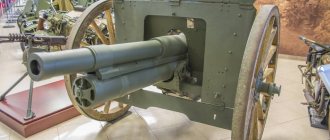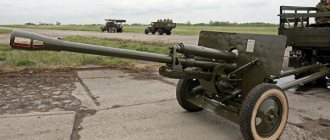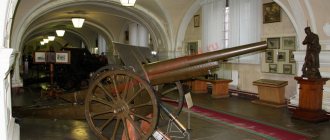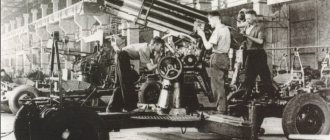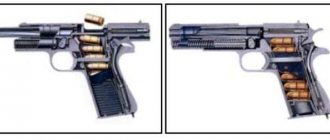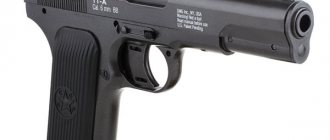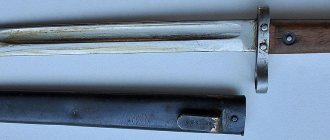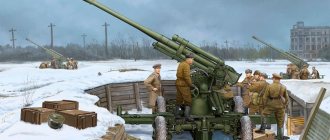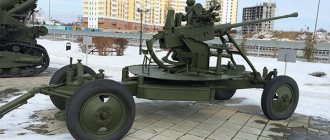Type of field gun
| M-46 or KS-30 | |
| 130 mm M-46 field gun | |
| Type | Field gun |
| Place of origin | Soviet Union |
| Service history | |
| Wars | Vietnam War [1] Border War with South Africa Six Day War [2] Yom Kippur War [2] Yom Kippur War Angolan Civil War Uganda-Tanzania War Iran-Iraq War First Nagorno-Karabakh War Yugoslav Wars Syrian Civil War Yemeni Civil War (2015–present) 2022 Nagorno-Karabakh conflict |
| Production history | |
| Designed by | 1946–1950 |
| Manufacturer | MOTZ |
| Produced | 1951–1971 |
| Characteristics | |
| Weight | 7.7 t (16,975 lb) |
| Length | 11.73 m (38 ft 6 in) |
| Barrel length | Bore: 7.15 m (23 ft 5 in) L/55 |
| Width | 2.45 m (8 ft) |
| Height | 2.55 m (8 ft 4 in) |
| Crew | 8 |
| Shell | 130 x 845 mm.R [3] (R / 184.6 mm) separate charge and projectile |
| Caliber | 130 mm (5.1 in) |
| Breech | Horizontal sliding wedge |
| Recoil | hydropneumatic |
| Shipping | Split trail |
| Height | −2.5° to 45° |
| Traverse | 50 ° |
| Rate of fire | 6 (normal) 8 (serial) 5 (long) |
| starting speed | 930 m/s (3,051 ft/s) |
| Maximum firing range | 27.5 km (17 miles) (unassisted) 38 km (23.61 miles) (assisted) |
130 mm towed field gun M-46
(Russian: 130-mm cannon M-46) is a hand-loaded, towed 130 mm artillery unit manufactured in the Soviet Union in the 1950s.
It was first spotted in the west in 1954. There is also a Chinese copy, called the Type 59
.
For many years, the M-46 was one of the longest-range artillery systems in the world, with a range of over 27 km. (16.7 miles)
Design history[edit]
In April 1946, an order was issued to develop a "duplex" artillery system to replace the obsolete 122 mm M1931/37 (A-19) gun, 152 mm M1937 (ML-20) howitzer and other World War II field guns. , such as 122 mm model 1931, 152 mm model 1910/30, 152 mm model 1935 (BR-2). The new systems, developed by Plant No. 172 (MOTZ), had a common carriage and were designated M-46 (130 mm) and M-47 (152 mm). Corresponding GRAU designations - 52-P-482
and
52-P-547
.
[ citation needed
] The development phase was completed in 1950, and mass production began a year later. Many M-46s were exported.
The second “duplex” artillery system was developed by the design bureau of F.F. Petrov at Artillery Plant No. 9. It consisted of a 122 mm gun and a 152 mm howitzer. The 122 mm cannon D-74 was a competitor to the M-46; and although many were produced, the M-46 became the only long-range gun in Soviet service until the introduction of new 152 mm guns in the 1970s.
Combat use of the 130-mm B-13 naval gun
During the Great Patriotic War, 130-mm B-13 guns became the most common medium-caliber naval guns. They were armed with all Soviet-built leaders and destroyers before 1945, a number of gunboats and some minelayers. By the beginning of hostilities in 1941, there were 169 such guns on coastal batteries, and during the war, several dozen more were installed in positions near Sevastopol, Novorossiysk, in the Crimea at Perekop and other places. Finally, these guns, placed on railway platforms, fought as part of armored trains or railway batteries.
The designers of the gun are now often criticized for the low elevation angle, which prevented anti-aircraft fire. This criticism is unfounded. To make a full-fledged 130-mm anti-aircraft gun, it is necessary not only to increase the maximum elevation angle to +85°, but also to create a remote system of high-speed gun pointing drives, a radar fire control system, fully automate the supply of ammunition, create an automatic installer for a remote tube on projectiles, etc. .d. In the early 30s and even in the pre-war years, this was beyond the capabilities of our industry. It was a completely different matter at the end of the 40s, when new universal 130-mm BL-109 guns appeared. Their capabilities needed to be expanded. However, the new destroyers of Project 30-bis continued to be equipped with pre-war B-2LM installations with swinging parts from the B-13.
130-mm B-57 railway mount - a land version of the B-13 naval gun
Still, the B-13 could conduct anti-aircraft fire. By 1941, its ammunition included remote (anti-aircraft) grenades of the 1928 model with a mechanical tube VM-16, and at the end of the 50s - anti-aircraft shells ZS-46R with a radio fuse. When the Germans tried to attack our ships from low or ultra-low altitudes, they often suffered significant losses, although in general the effectiveness of using the cannon as an anti-aircraft gun was low.
During the war years, a number of disadvantages of the B-13 turned into its advantages. For example, the absence of electric guidance drives, manual loading, etc. - thanks to this, guns intended for destroyers were placed without any changes in a few hours on the decks of barges, scows, on ordinary four-axle railway platforms or on improvised foundations somewhere in an open field near Moscow or Perekop. No power source or radar fire control system is needed.
Initially, the guns were produced with a box-shaped shield, and from the second half of 1939 - with a streamlined shield. Those produced before 1939 were called installations of the first series, and later - the second series (B-13-Is). In 1948, production of the third series (B-13-Shs) began. The main difference between them was the design of the rammer.
The B-13 artillery mounts were discontinued only in 1954, and a total of 885 units were produced. And in the post-war years, B-13s made up the majority of the USSR's coastal defense guns. For 35 years, they were operated in China on four Project 7 destroyers transferred to it in 1955. By the mid-80s, the Navy had over 600 B-13 units in service and warehouses.
130-mm artillery mount B-13, rear view
Description[edit]
The M-46 was developed from the 130 mm M-36 naval gun used on ships and for coastal defense. It is a true shotgun, which cannot fire much above 45°, has a long barrel and a single propellant charge. In contrast, most Western field guns of this period had the ability to fire at high and low angles, namely the howitzer gun.
It has a 39 caliber barrel with a horizontally sliding hatch and a “peppercorn” type muzzle brake. The latter is not particularly effective, but subjective reports indicate that it is quite effective in reducing muzzle flash. The hydro-pneumatic recoil system contains a buffer under the barrel and a recuperator above the barrel. The long barrel provides a significant propellant charge, providing greater length to achieve a "complete burn" and therefore space for the projectile to accelerate and thus achieve its muzzle velocity of 930 m/s.
The barrel is mounted on a split carriage, with deep box-section plumes and foam-filled support rollers on the ground when firing and a 50° tilt angle at the top. The small shield provides little more protection than a scope, possibly including muzzle blast, and some protection from machine gun fire in anti-tank combat. The gun has long, strong trails to provide stability when firing, and a large, removable spade is attached to the end of each when the gun is fired.
Non-return sights are standard Soviet type, designed for single aiming. The kit includes a direct-fire anti-tank optical sight, a panoramic periscope sight with closed aiming (circular sight) on a reciprocating installation, an aiming angle scale and a drum with an engraving of the range (range) scale, connected to a hinged height leveling bubble. The distance drum allows the use of the standard Soviet direct fire technique, where the gun is visually aimed at the target, and the range is set on the range drum. Later, the APN-3 was provided instead of a daytime telescope for direct fire at night.
For movement, the implement is towed using a two-wheel limber mounted at the end of a closed trail, with shovels being removed and carried along each trail. Simple track jacks just behind the main wheels are used to lift and support closed tracks so the front end can be attached. The barrel and the recuperator are retracted between closed guides and fixed in the stowed position. To achieve this, there is a large bicycle chain on the right track, and a compressed air tank, charged by the shot, is used to move the barrel forward when the gun is returned to action. It takes about four minutes to activate the gun, a normal squad of eight people.
Propelling charges are contained in metal casings and are loaded separately from the projectile. Initially, projectiles included fragmentation rounds, armor-piercing rounds, smoke, illumination, and chemical rounds. High-explosive fragmentation shells weigh about 33 kg. Illumination rounds have a significantly lower muzzle velocity. Later, APHE and extended range projectiles were introduced. The maximum rate of fire is probably 6-7 rounds per minute, and approximately 70 rounds per hour. The standard Soviet firing unit was 80 rounds. [4] [5] [6]
Last Sunday, the famous Eurosatory 2016 land weapons exhibition opened in the Parisian suburb of Villepant. The exhibition was attended by more than 1,500 defense companies from 57 countries. The French pavilion, as the host country, is the most widely represented - 546 companies exhibited new military equipment.The French are followed by a large margin by the Americans with a cluster of 135 companies and the gloomy Teutonic genius, who has put up a fist of 112 companies against competitors.
Despite the fact that Russian defense industry enterprises are still subject to the sanctions regime, Europeans clearly do not have enough duct tape, so 12 Russian defense enterprises under the leadership of Rosoboronexport came to show their goods to the city of Paris.
According to the organizing committee of Eurosatory 2016, the main focus of the exhibition will be on unmanned aerial vehicles, as well as everything related to cyber defense. However, against the backdrop of the military operation of the Russian Aerospace Forces in Syria, there is an increased interest in various modifications of the BMP-3 infantry fighting vehicle, the T-90S and T-90MS main battle tanks, the Smerch MLRS, the BTR-82A, and the SPM special police vehicle -2 GAZ-233136, Pantsir-S1, Tor-M2KM and Buk-M2E anti-aircraft missile systems, Ka-52 and Mi-28NE combat helicopters.
The opening of Eurosatory 2016 was immediately marked by a loud statement. The famous company from Düsseldorf, Rheinmetall AG, which has branches and factories in 18 countries, has attracted close attention by challenging the “pride of tank Russia” in the form of the T-90 tank and the newest T-14 on the Armata platform. The company recently built a prototype of a new high-power tank gun with a total weight of almost 3 tons, of which 1.4 tons are in a chrome-plated 130 mm barrel with a length of 51 calibers.
It would not be so interesting if a company slightly less eminent than Rheinmetall suddenly began to puff out its cheeks. Almost all modern NATO tanks are equipped with Rheinmetall tank guns. If not original production, then licensed. Even Abrams. As well as tanks from those countries that have adopted NATO standards.
In addition, Rheinmetall gained access to interesting military technologies from Denel Defense from South Africa. And he even acquired 51% of the shares of this company. Denel once managed to develop and build an excellent self-propelled 155 mm howitzer and a system for simultaneously hitting a target with three shells fired from one gun at different barrel angles.
Well, since Rheinmetall insists, we can compete with guns.
Until recently, the main domestic guns were versions of the well-known 2A46M tank gun. The latest modification, 2A46M-5, has a 15-20% higher firing accuracy, and the total dispersion when firing on the move has decreased by 1.7 times. Thanks to modifications, the gun acquired the ability to fire new armor-piercing sub-caliber projectiles of increased power.
The best Western gun is currently considered to be the 120 mm L-55 smoothbore gun with a 55-caliber barrel of the Leopard-2A6 tank. Compared to the old 120 mm smoothbore gun L-44, the barrel length of the L-55 has been increased by 130 cm. The DM-53 and DM-63 shells used in this gun have very high armor penetration characteristics. And this despite the fact that, unlike American ammunition, the Germans use tungsten as the core material, rather than depleted uranium.
While the Germans were creating their wunder shells, the Russian gunners were not scratching their bellies, and in the early 2000s they built a new 125 mm tank gun 2A82.
For the new 2A82 gun, new ammunition was developed for the BPS “Vacuum-1” with a length of 900 mm, the “Telnik” projectile (I never tire of being amazed at the domestic tradition of naming military equipment and ammunition) with a detonation on the trajectory, as well as the “Sprinter” guided missile projectile.
The 2A82 gun with an auto-bonded and partially chrome-plated barrel is capable of firing both existing and future ammunition. In terms of technical level, it surpasses all existing tank guns by 1.2-1.25 times. The muzzle energy of the 2A82 gun is 1.17 times greater than the best NATO gun - the 120 mm system of the Leopard-2A6 tank, while the barrel length of our gun is 60 cm shorter.
They decided to modernize the 2A82 gun for the Armata, lengthening the barrel by a whole meter - up to 7 m.
The Germans are making an electrothermochemical gun based on the Rh120L55. Domestic gunners, which is typical, are not lagging behind and are moving in the same direction. As part of the research work, the first experiments on ETC shooting were carried out under the eloquent code names “Levsha” and “Levsha-M”.
News is coming from laboratories and experimental testing sites that amazing results have been achieved. The ETX firing range of a tank gun has been increased by 1.5-2 times compared to standard weapons. A decision has already been made to develop this direction using the existing 2A82 type gun.
By the way, the ETX gun was once developed for the navy, but has now found application in tank building.
New ammunition for the 2A82 guns of the T-14 Armata tank successfully passed state tests in 2013 and was accepted for supply.
Their serial production began, the first batch was accepted by representatives of the Ministry of Defense in 2013 and sent to arsenals for combat support. Thus, by the time the T-14 is put into service, a necessary and sufficient supply of shells will be created for it, including for ongoing combat training.
After the victory parade on May 9, 2015, information appeared from official sources about the modernization of the T-14 gun and the installation of a 152 mm gun on it. Thus, Armata tanks with a 125 mm cannon will be released in small numbers and only the first vehicles.
The 152 mm caliber gun for installation on the T-14 tank is the 2A83 gun, once built for the promising T-95 tank. The T-95 project did not take off, but the gun very much remained and is still being produced at full speed at the Yekaterinburg “Plant No. 9”.
The body of the gun is based on the 2A65 howitzer-gun, already mastered in production, which forms the basis of the Msta artillery complex. However, unlike the latter, the 2A83 has smooth barrel walls and is distinguished by a bolt design coupled with an automatic loader. Moreover, the barrel inside has a chrome coating, which allows the pressure of the powder gases to be increased to 7,700 atm, while for current tank guns it does not exceed 3,000 atm.
Projectiles fired from the 2A83 gun have a speed of 1900 m/sec, which is 200 m/sec higher than the speed of a projectile fired from the best NATO tank gun. But here’s another piece of candy for you: thanks to the special design of the stabilizers, the 2A83 sub-caliber projectile maintains a speed of 1900 m/sec at a distance of 2000 meters.
The range of ammunition for the 2A83, in addition to armor-piercing sub-caliber, includes high-explosive fragmentation, cumulative fragmentation, cluster and thermobaric volumetric explosion ammunition. It is possible to fire a guided projectile of the Krasnopol type. The missile fired from the barrel is similar to the Kornet ATGM missile and can burn through 1200 mm of homogeneous armor.
Thus, even taking into account the coolness (by the way, until 2014, she worked under a contract with the Russian Defense Ministry in the construction of a new training ground near Nizhny and for the modernization of the combat support of the Russian Army), I would really like to remind the respected dog knights not to boast, going to the army. And not so much while walking, but from behind the desks of military exhibitions.
According to representatives of Rheinmetall itself, their new 130/51 tank gun will go into production no earlier than 2025. In addition, advertising brochures and engineers' statements differ markedly in tone. Although the talking heads at the exhibition convince that the new weapon can be equipped with the Leopard-2A5 and 2A6 tanks currently in service, from the bowels of Rheinmetal there is a dull message that “a new turret is being developed, unified in design with the existing turret of this tank.” In general, it is planned to equip a promising tank with a 130 mm cannon from Rheinmetall, which will only be developed by a joint team of German and French engineers.
And we have not yet touched upon such performance characteristics of the T-14 as armor and the Afghanit active protection complex. And it somehow comes out like a kindergartener. Having only a prototype tank gun, not a production model, and making loud statements, ignoring the closed nature of the performance characteristics of the T-14 "Armata" and a solid counterweight in the form of a serial 2A83 gun...
It reeks of Poroshenkoism.
Comments (0) | Print | | Complaint
Source:
https://www.politnavigator.net/rejjnmetall-protiv-armaty-pomeryaemsya-pushkami.html
History of operations[edit]
Israeli M-46s open fire on Syrian positions during the Yom Kippur War.
The M-46 was first seen openly at the 1954 May Day parade in Moscow. It initially replaced the 100 mm BS-3 field and anti-tank gun. However, its long range made it well suited for counter-battery operations—some Western troops receiving it reported poor fragmentation, and large fragments would suit the purpose of counter-battery warfare. It was also reported for Soviet use with an integrated fire control system including SNAR-2 radars. In Soviet service, M-46 battalions were in army and front-line artillery brigades.
It is or was in service with at least 25 countries and was produced under license in China as the Type 59. In Soviet/Russian inventories it was replaced by the 2A36 Giatsint-B and the 2S5 Giatsint-S self-propelled gun. Several companies, such as Soltam and RDM Technology BV, have introduced upgrade packages for the pistol. These include, for example, upgrading to a 155 mm 45 caliber gun.
The M-46 saw extensive combat service with the People's Armed Forces for the Liberation of Angola (FAPLA) during the Angolan Civil War and the Border War with South Africa. [7] From the mid to late 1970s, Angolan M-46s were used with some success in counterbattery roles against South African artillery units that possessed the comparatively small 5.5-inch BL medium guns. [8] South Africa later acquired six M-46s from Israel for evaluation purposes; this likely influenced the development of the G5 howitzer, which was adopted to combat the range and effectiveness of FAPLA field guns. [9]Cuba also deployed its own M-46 batteries to support FAPLA operations during its long military intervention in Angola. [10] Cuban and FAPLA M-46s were most notably used during the Battle of Cuito Cuanavale, where individual guns were deployed in ones or twos rather than concentrated on individual positions to reduce the threat posed by counter-battery fire from South African G5s. [11] Cuban tacticians were able to repeatedly stop South African mechanized and armored advances by using minefields to funnel attackers into chokepoints where M-46s could concentrate their fire. [eleven]
The Tanzania People's Defense Force fielded several M-46 guns during the Uganda–Tanzania War of 1978–1979. [12]
A variant of this weapon, possibly a Chinese-made Type 59-1, was allegedly used by North Korea to shell South Korea's Yeonpyeong Island in the Yellow Sea on November 23, 2010.
KM-2 "Krasnopol-M2"
155-mm version of the Krasnopol-M guided artillery projectile (to NATO standards). Includes an adjustable high-explosive fragmentation projectile K155M of 155 mm caliber, with semi-active homing to a target illuminated by a laser. Designed to destroy stationary and moving armored and unarmored targets and engineering structures at a distance of up to 25 km, with the first shot. The method of destruction is from above, along a takeoff-dive trajectory.
Supplied to India and China, produced under license in China. For the Krasnopol-M complex, CILAS (France) developed a laser target designation system DHY307; in 2001, to confirm its compatibility with Krasnopol, firing tests using DHY307 were carried out in France.
Options [edit]
Soviet Union[edit]
- The M-47
is a 152 mm field gun (Russian: 152-мм cannon M-47 mod. 1953), which was developed together with the M-46. The M-47 had a range of 20,470 m and was much less successful than its 130 mm counterpart. Only a small number were built between 1954 and 1957. Externally, the M-46 and M-47 are almost identical, with the exception of caliber.
China[edit]
Iraqi Type 59-1
- Type 59
is a licensed version of the M-46. [13] - Type 59-1
is a combination of 130 mm Type 59 ammunition with a Type 60 carriage (copy of D-74).
The result was a gun with the same firing range as the M-46, but with a much lighter weight - 6.3 tons. The M59-1M
is an Egyptian license version. A version with an APU and a redesigned carriage was developed for the export market. A self-propelled variant based on the Type 83 SPH was also developed for the export market. [14] - Type GM-45
- For the export market, NORINCO (China North Industries Corporation) has developed this upgrade package, which replaces the original Type 59 barrel with 155/45mm WA 021 ammunition. The GM-45 type has a maximum range of 39 km when using ERFB-BB ammunition. [13]
Cuba[edit]
- The Cuban Army uses two different versions of the locally produced M-46 self-propelled gun. One is based on the tracked chassis of the T-34-85 tank, and the other is based on a heavily modified KrAZ 6x6 truck. These and other modifications were first shown at the 2006 military parade. [ citation needed
]
Egypt [edit]
- The Egyptian Army operates a locally assembled version of the M-46 [15]
India[edit]
- The Indian Army has a total of about 1,000 of the 130 mm towed guns that were acquired from the former Soviet Union since 1968.[16]
- 155 mm Soltam guns with improved armament.
In 2008, the Israeli company Soltam upgraded the armament to 155 mm guns from the 130 mm guns of the Indian Army [16].
- IOB Sharang 155mm/45 caliber guns
- Another 155mm upgrade (45 caliber) to the 300 M-46 towed guns developed by the Ordnance Factory Board (OFB). The modernized M-46 has a flight range of 39 km. [17] On 25 October 2022, the Indian Ministry of Defense awarded a contract worth INR 2 billion (US$27.2 million) to the Ordnance Factory Board (OFB) to modernize 300 of the 130 Soviet-era weapons of the Indian Army (IA). M-46 field guns from 52 mm/52 caliber to 155 mm/45 caliber in an attempt to increase its firepower. [18]
- SP-130 "Catapult"
is a self-propelled version of the Indian design, installed on the hull of the Vijayanta tank. [13]
Israel[edit]
- The M-46S
is a refurbishment of the existing M-46 or Type 59 by Soltam Systems Ltd.
The original barrel has been replaced by a new 155/45mm model (Western ammunition) with a range of 25.8 (HE). up to 39 km (ERFB-BB). A 39 caliber barrel is optional. In March 2000, Soltam won a contract worth $47,524,137 to upgrade 180 M-46s to the M-46S standard (index in India: 155/45mm (E1) Soltam
). An additional deal was concluded for 250 retrofit kits. In 2005, after only 40 howitzers had been completed, the M-46S program was terminated due to a fatal barrel explosion. [13]
Democratic People's Republic of Korea[edit]
US military intelligence has reported the existence of a number of locally developed self-propelled artillery systems, including the SPG 130mm M1975
, then
SPG 130 mm M1981
and
SPG 130 mm M1991
. No details available, but it appears to be an M-46/Type 59 mounted on a Tocchon tracked chassis. [13]
Serbia[edit]
- The M46/84
is a modification that involved replacing the original 130mm barrel with a new 155/45mm or 152mm barrel. This version with ERFB-BB ammunition has a range of 38,600 m, and with the M05 152 mm the range exceeds 40 km. [14]
Netherlands [edit]
- RDM Technology BV is another company that offers an M-46/Type 59 upgrade that includes the installation of a new 155/45mm barrel. [13]
Romania [edit]
- A412
- Licensed Chinese Type 59-1 with D-20 carriage.
[19] In service with the Romanian Army, the A412 is known as the M1982 130 mm towed gun
(Romanian: Tun calibrul 130 mm tract M1982). The A412 was also exported. [13]
The Type 59-1 was produced by Arsenal Resita as the A412 Model 1982 between 1982 and 1989. The maximum flight range was 33 kilometers using NORINCO Base Bleed ammunition. The A412 cannon can fire 7-8 rounds per minute. The A412 was exported to four other countries: Bosnia and Herzegovina, Cameroon, Guinea and Nigeria.
M-46 gun design
The barrel consists of a pipe, casing, breech and muzzle brake with an efficiency of 35-39%.
The breech is screwed onto the casing.
The shutter was a horizontal wedge and opened to the right. There is no semi-automatic operation, the wedge opens and closes manually
The rollback brake is hydraulic; the rollback brake cylinder is fixed in the cradle cages and is motionless during rollback.
The knurl is hydropneumatic. The recoil devices are filled with Steol-M liquid. The rollback length is variable. The maximum rollback length “STOP” is 1350 mm.
The lifting and rotating mechanisms are sector-type (they have one sector each).
For aiming, an artillery panorama PG-1, a mechanical sight S-71, an artificial aiming point collimator K-1 are used, and the Luch device is used to illuminate the scales of the sight, panorama and collimator at night.
The balancing mechanism is pneumatic, push-type, and consists of two columns located symmetrically on both sides of the barrel.
Welded box frames.
The shield cover consists of the left and right halves of the shield and casing. A 4 mm thick casing is placed on the knurling cylinder.
The wheels are single-pitch with a sponge rubber (GK) tire measuring 1350x380 mm.
Torsion bar suspension.
In the stowed position, the barrel is pulled back and secured to the frames. The frames in the raised position are mounted on the front end.
In emergency cases, the gun can be transported over short distances in a firing position (without a limber) at a speed of up to 5 km/h.
Standard ATS tractor.
Rice. 3 130 mm M-46 cannon in tow position
The M-46 system was exported to many countries around the world and participated in a number of local conflicts, including an artillery duel in the Taiwan Strait in the late 50s, conflicts in Indochina and the Middle East. During the Sino-Taiwan conflict, it was not possible to hit targets located on the other side of the Taiwan Strait at ranges exceeding 27 km from the M46 cannon. However, Soviet military instructors found a non-standard solution. Having waited for a fair wind and heated up the full propellant powder charges, they were able, by changing the ballistic characteristics, to significantly increase the maximum firing range and cover targets on the other side of the strait.
Rice. 4 130 mm M-46 cannon in tow position
The production of the M-46 gun was established in Egypt. Foreign arms companies are constantly working to modernize the M-46 gun and its ammunition. Ammunition for the M-46 is produced in at least 12 countries, from northern Finland (PatriaVammas) to southern Africa (Denel).
The variety of manufacturers of ammunition for the M-46 is only a small indication of how widespread this gun is around the world. For example, when using shells with a bottom gas generator (as, for example, the IranianDefenseIndustriesOrganization company did), the firing range can be significantly increased - up to 37,000 m. The high safety margin of the M-46 gun design, prudently laid down by Soviet designers back in 1946, allows modernization by replacing the 130 mm barrel with a 155 mm barrel, using standard NATO ammunition for firing.
SpaceResearch Corporation (SRC), best known for Dr. Gerald Vincent Bull (the ordnance genius who designed Saddam Hussein's huge supergun capable of launching a payload into orbit around the Earth), was also involved in the M-46 modernization process from the very beginning.
China received technical documentation and full-scale samples of the 130 mm M-46 towed gun from the Soviet Union in the mid-1950s, and later developed a Chinese copy known as the Type 59 in 1959.
In 1970, the manufacturer introduced an improved version of the Type 59 gun. The design of the gun made it possible to transport it on two wheels. The modernization resulted in a weight reduction of the gun by 2.5 tons compared to the original Soviet M-46 design. The modernized Type 59 gun was adopted by the Chinese army in the early 1970s.
During the 1979 Sino-Vietnamese border conflict, the Type 59 long-range gun played a key role in the battles and performed highly.
Chinese Type 59 guns were exported to the Iraqi Army. In the 1980s they were used during the war between Iran and Iraq, as well as during the Gulf War in 1990-91.
Chinese gun makers produced more than 1,000 guns, which ceased production in the mid-1980s. A significant number of Type 59 guns are currently still in service with the Chinese army.
In the future, it is planned to replace the Type 59 guns with a modern towed howitzer of 155 mm caliber with a barrel length of 45 calibers called PLL01.
Between 1980 and 1990, the Chinese corporation NORINCO (ChinaNorth Industries Corporation) developed a number of new 130 mm projectiles for Type 59 guns, including:
- extended-range high-explosive fragmentation projectile (Extended-RangeHE) with a firing range of up to 30 km;
- high-explosive fragmentation projectile with a gas generator (BaseBleedHE) with a firing range of up to 37 km;
- active-reactive high-explosive fragmentation projectile (RocketExtended-RangeHE) with a firing range of up to 37 km;
- Extended-range high-explosive fragmentation projectile with ready rifling (ERFB/HE) with a firing range of up to 32 km.
- highly effective incendiary projectile with a firing range of up to 27.5 km.
- fragmentation-shrapnel projectile, equipped with 10,000 thousand balls and with preliminary fragmentation of the body with a firing range of up to 25 km.
- cluster anti-tank projectile with 35 damaging combat elements with a firing range of up to 25 km.
- smoke projectile with a firing range of up to 25 km.
Norinco Corporation also developed a 152-mm GM-45 gun based on the M-46.
Rice. 5 152-mm Chinese GM-45 gun in stowed position.
Rice. 6 152-mm Chinese GM-45 gun in firing position.
Chinese artillery specialists went even further, a modernized M-46 called Type 59-1 was installed on a self-propelled tracked chassis. The 130-mm experimental self-propelled gun was named Type 321, however, it was not mass-produced due to lack of demand from both domestic and foreign customers.
Rice. 7 130 mm Chinese self-propelled experimental gun Type 321
The former Yugoslavia offered two options for upgrading the M-46 gun, the M-46-86 model with a 152 mm caliber barrel, 46 calibers long, and the M-46-84 model with a 155 mm caliber barrel, 45 calibers long.
The Israeli company Soltam managed to interest the Indian army with its M-46 modernization project, which is armed with about 1,200 M-46 guns. However, it seems that Indian designers have developed their own project under the designation Metamorphosis. The Indian project is still under development. It is expected that in the future all M-46 guns of the Indian Army will be re-equipped with 155 mm caliber barrels. The Dutch company RDM Technologies also offers modernization of the M-46 by switching to the 155 mm caliber.
These ideas were implemented long ago in the former USSR in the form of the 152 mm M-47 cannon, created simultaneously according to the same design on a single M-46 carriage.
Currently, Motovilikha Plants OJSC is modernizing existing M-46 systems, which includes:
- replacement of the 130 mm barrel with a 155 mm barrel for standard NATO ammunition;
- installation of a semi-automatic shutter and rammer for chambering a shot;
- introduction of an automated guidance and fire control system (AFCS) using angle measuring systems, computers and displays;
- modification of recoil devices in order to reduce the length of the rollback.
Modernization of the M-46 allows:
- increase the maximum firing range to 28 km;
- increase the weight of the projectile to 43.5 kg;
- increase the mass of the powder charge to 15 kg;
- use standard NATO ammunition;
- make loading easier and faster;
- significantly reduce the time for preparing calculation data for the first shot.
The upgraded gun is 700 kg heavier than the standard one.
Rice. 8 152-mm M-46 gun modernized at the Motovilikha plant
And the experience of making mistakes is difficult...
For all its advantages, the M-46 gun had (or still has) one significant drawback.
When designing the projectile, the designers, for reasons known only to them, set inflated requirements for the accuracy of combat when firing at a maximum distance of D = 27,300 m.
When conducting tests, it is very difficult to obtain accuracy that meets the requirements of the drawing.
The accuracy of combat over the terrain is determined by the ratio of the probable dispersion of projectiles - Vd to the firing distance - X; for field systems, the ratio Vd / X is mainly within 1/200. For shells for the M-46, the denominator of this fraction is slightly larger, and it was not always possible to reach this “slightly”, despite any efforts and tricks of the test site.
No one could change the denominator of the fraction downward, at least to 1/200, since the old O.F. laid down the previously established requirements for combat accuracy.
The amount of projectile dispersion over range - Vd - is taken as the basis for calculating projectile consumption rates for hitting (suppressing) targets, and an increase in Vd will entail an increase in the number of projectiles, and this is an increase in the cost-effectiveness indicator. “What is written with a pen cannot be cut out with an axe,” says the Russian proverb, although the shell designers, shell manufacturers and rangers understood that the requirements for combat accuracy were too high, but they could not do anything. The “healthy” conservatism of the military prevailed: “why change something when it’s already good!”
At the same time, no one took into account how much effort, money and nerves went into repeated testing, coordination and signing of various decisions and regulations at all possible levels.
Projectile designers, when asked “Why so often does the accuracy required by the drawing requirements fail?” answered something like this: “the reason is probably the insufficient gyroscopic stability of the projectile at the descending point of the trajectory.”
If the “one hundred and thirty” arrived at the testing site, intensive preparation began. The shooting was carried out from a firing position located on the first kilometer of the battlefield, where there was only one position left, since in connection with the construction of new workshops and facilities for the production of missile systems on the test site route, the main firing positions were moved eight kilometers forward. We had to shoot from the M-46 almost from the territory of nearby summer cottages. The width of the combat field of the training ground ranged from 2 to 4 kilometers. A combat projectile fired from a cannon flew at altitudes of up to 10 km over the territory of the plant, built up with workshops and structures where people were located and missile systems were being assembled.
As a rule, the tests were planned to be carried out during the lunch break in order to protect the production personnel in the workshops, but due to weather conditions or for some other reason, this was not always possible.
Theoretically, during shooting, all people should have taken cover, but in practice, these requirements, to put it mildly, were not always met. Errors in aiming the gun when firing under such conditions could lead to unpredictable consequences, so tests from the M-46 were carried out by experiment managers with extensive experience.
For safety reasons, the first sighting shot was fired with a projectile in inert ammunition, and the B-429 combat fuse, set to “O” (fragmentation action), was used with a cap to prevent premature rupture of the combat projectile along the trajectory in the event of an accidental collision with birds or when the projectile flies zones of intense precipitation in the form of hail and heavy rain.
Early in the morning, the M-46 was placed on the front and along the road, and then transported along the dirt road using an ATT or tank to a firing position. The cannon was installed on a platform made of sleepers, the coulters of the frames were rested against oak logs, then with the help of a tractor they pulled the cannon back, sleepers were placed under the wheels, which were firmly nailed to the platform with staples. The gun simply could not move anywhere. In winter, in the dugout next to the OP, the stove was lit in advance, then extinguished. Ammunition was brought in in a closed vehicle with a red flag and carried into the dugout to ensure the stability of the temperature of the shots. At the same time, the gun was carefully prepared for test firing.
The following checks followed: control napkin - cleanliness of the barrel, zero aiming line, pressure in the knurl, amount of fluid in the recoil brake, the operation of the balancing mechanism was especially carefully checked at a barrel elevation angle of 45 degrees. The pressure in the balancing mechanism was set to such a level that the force on the flywheel was constant, and the barrel moved up and down in the range of 45 plus - minus one degree smoothly without sudden jerks.
Rice. 9 130-mm M-46 gun in a combat position
And then the almost sacred rite began. The shooting was carried out, with the exception of rare cases, by the head of the testing bureau, Lev Valerianovich Znamensky. After loading the gun with the next shot, setting the calculated lateral deflection of the projectile from the central direction of the firing range and aiming the crosshairs of the PG-1 panorama at the aiming point 1000 meters away, he placed a quadrant with a set angle of 7-50 (45 degrees), elevations on the control platform according to the risks on the breech. RO and the gunner, who was slowly rotating the flywheel of the lifting mechanism, held their breath and looked at the slowly creeping air bubble of the quadrant, accompanying its movement with the words: “It’s gone a little, a hair’s breadth!!! Again!".
The aiming of each shot was sometimes repeated several times. With some kind of sixth sense, Lev Valerianovich determined the moment when to give the command to the gunner “Good!” so that he would stop rotating the flywheel of the lifting mechanism, taking into account the inertia of the barrel movement. But all these tricks did not always give the desired results.
Every third batch of shells failed, that is, the accuracy did not meet the requirements of the drawing. The only salvation for the factories was that during the retest, two groups of shells were fired, the result was considered as the arithmetic mean of the two groups of shells retested. The average of the two groups was generally satisfactory.
Rice. 10 "Weapon!"
Leonid Efimovich Komissarenko talks about the tests of the “one hundred and thirty”.
Information: Leonid Efimovich Komissarenko - former (1976-1992) head of SKB - Chief Designer of the Donetsk Tochmash Plant (since 1979, PA Tochmash).
Leonid Efimovich has extensive practical experience in the manufacture of shells and testing for various artillery systems.
From 1958 to 1969 he worked in the workshops of the plant: foreman, technologist, head of the technology bureau.
Awarded: the medal “For Labor Valor” and others, Laureate of the USSR State Prize in 1987 for developing the 152mm OFS for the Msta system as part of the creative team for Mste-S.
He has 21 copyright certificates, two of which are officially recognized as having great national economic significance.
Shells[edit]
- Frag-OF
,
3OF33 (with a full charge of 3VOF43)
- range: 27,490 meters - Fragmentation HE
,
3OF33 (with separate charge 3VOF44)
- range: 22,490 meters - Frag-HE
,
ERFB-BB
- Extended Full Bore Range - Basic Bleed, Range: 38,000 meters - APCBC-HE-T
,
BR-482
and
BR-482B
- range: 1140 meters - Slave Shell
,
Firn-1
- range: 24,000 meters - Smoke
- Chemical
- Lighting
Operators[edit]
Map showing M1954 operators in blue with former operators in red
M-46 in the Israeli Museum. Note that the carriage is equipped with an additional axle and wheels to provide "walking" suspension, and a sole is added.
- Algeria: 10 [20]
- Angola: 146 acquired from the Soviet Union and Bulgaria. [20] 48 in service. [21]
- Azerbaijan: 36 purchased from Bulgaria. [22]
- Bangladesh: 62; Type 59-1 variant [21]
- Bosnia and Herzegovina: 8; Option A412 [20]
- Cambodia: Type 59-1 [20]
- Cameroon: 12; Option A412 [20]
- People's Republic of China: 234 in service in 2016; Type 59 and Type 59-1 variants [21]
- Republic of the Congo: 5 [20]
- Democratic Republic of the Congo: 42; Type 59 and Type-59-1 variants [21]
- Croatia: 19; M-46H1 variant [21]
- Cuba: 197 [20]
- Egypt: 650; 250 M-46 and 400 Type 59-1M [20]
- Eritrea: 39 acquired from Bulgaria. [20]
- Ethiopia: 114 [20]
- Guinea: 12; Option A412 [20]
- Guyana: 6 [21]
- India: ~600 in service and ~500 in reserve. 200 upgraded to 155 mm caliber. 20 self-propelled guns are in service and another 40 are on order. [21]
- Iran: 726; 100 M-46s and 626 Type 59s. [20] Another estimate gives 985 M-46s. [21]
- Iraq: 676; [20] M-46 and Type 59 variants. [21]
- Laos: 10 [20]
- Lebanon: 15 [21] -16 [20]
- Libya: 330 [20]
- Mongolia: 50 [20]
- Morocco: 18 [21]
- Mozambique: 24. [20] 6 in service in 2016. [21]
- Myanmar: 16 Type 59-1 and 160 M-46 in service. [23] [21]
- Nigeria: 4; Option A412. [20] Another estimate gives 7 M-46s. [21]
- North Korea: 210; 160 M-46 and 50 Type 59 [20]
- Oman: 15 received from unidentified source. [20] Another source gives 12 M-46s and 12 Type 59-1s. [21]
- Pakistan: 360; 100 M-46s and 260 Type 59s. [20] [24] Other estimates place 410 Type 59-1s in service in 2016. [21]
- Peru: from 30 [20] to 36 [21]
- Romania: 75; Option A412 [25]
- Serbia: [26] 36 [21]
- South Sudan [21]
- Sri Lanka: from 12 [20] to 30; [21] Type 59 or variant Type 59-1 [20]
- Sudan: 30 [20] vs. 75; [21] Type 59 variant [20]
- Syria: 650 [20] Free Syrian Army [27]
Former operators[edit]
Republika Srpska Army M-46 guns during the Bosnian War.
- Soviet Union
- Afghanistan: 428 [20]
- People's Socialist Republic of Albania: 100; Type 59 variant [20]
- People's Republic of Bulgaria: 72 [20]
- East Germany: 175 [20]
- Finland: 20 acquired from the Soviet Union in 1965-1966 and 166 from the former East Germany in 1993. [20] In 2016, 36 were still in service under the designation 130 K 54
. Filmed 2022. - Germany: former East German guns. 166 sold to Finland in 1993.
- Israel: captured from Syria and Egypt. [9] 100 in the store. [21]
- Islamic State: 34 [28] [29]
- Palestine Liberation Organization: 10 acquired from East Germany. [20]
- People's Republic of Kampuchea: 30 [20]
- Russia: in store [21]
- Somalia: 10; Type 59 variant [20]
- South Africa: 6 players loaned from Israel, later returned. [9]
- South Lebanon Army: 5 purchased from Israel. [20]
- Yugoslavia: 186 [20]
Modifications
MT-12K (2A29K)
In 1981, the 9K116 “Kastet” anti-tank missile system (Tula KBP headed by A.G. Shipunov), designed to destroy armored vehicles, as well as small targets, was adopted by the USSR ground forces. The “Kastet” complex consists of a ZUBK10 shot with a 9M117 guided missile and 9Sh135 aiming and guidance equipment. The control system is semi-automatic using a laser beam.
AK "Tulamashzavod" has mastered serial production of the modernized 9M117M "Kan" ATGM missile as part of the 3UBK10M round with a tandem cumulative warhead capable of penetrating the armor of tanks equipped with dynamic protection.
MT-12R (2A29R)
The MT-12R, “Ruta” complex was adopted and put into serial production in 1981. The all-weather radar sighting system 1A31, code "Ruta", installed on the MT-12 anti-tank gun, was created in 1980 at the Design Bureau of the Strela Research Institute (Chief Designer V. I. Simachev). The production of the 1A31 sight was carried out in 1981-1990.
M87 TOPAZ
Yugoslav modification of MT-12. The main feature is the use of a carriage from the D-30 howitzer. The OMS also includes a laser rangefinder with a range from 200 to 9995 meters.
Links[edit]
- Tucker, Spencer S., ed. (May 2011). Encyclopedia of the Vietnam War: Political, Social and Military History (2nd ed.). item 1251. ISBN 978-1-85109-960-3.
- ↑
Dunstan, Simon (10 November 2009). Six Day War 1967: Jordan and Syria. Campaign 212. Osprey Publishing. paragraph 65. ISBN 978-1-84603-364-3. - ordnanceandmilitaria.com/110-to-149mm-ammo
- Red God of War - Soviet Artillery and Rocket Forces
, Chris Bellamy, Brassis, 1986. ISBN 0-08-031200-4 - Artillery of the World, ed. Shelford Bidwell, Brassis, 1977 ISBN 0-904609-04-9
- Encyclopedia of World Military Weapons
1988. ISBN 0-517-65341-9 - Vanneman, Peter (1990). Soviet Strategy in Southern Africa: Gorbachev's Pragmatic Approach. Stanford: Hoover Institution Press. pp. 41–51. ISBN 978-0-8179-8902-6.
- Harms, Kyle; Dunstan, Simon (23 February 2022). South African Border War Armor 1975–89
. Oxford: Osprey Publishing. pp. 31–38. ISBN 978-1-4728-1743-3. - ^ abc Leon Engelbrecht. "Self-propelled towed gun-howitzer G6 L45". Archived from the original on January 9, 2014. Retrieved November 13, 2014.
- George, Edward (2005). Cuban intervention in Angola. New York: Frank Cass Publishing. paragraph 226. ISBN 978-0-415-64710-6.
- ^ab Bridgeland, Fred (1990). The War for Africa: Twelve Months That Changed a Continent
. Gibraltar: Ashanti Publishing. pp. 300–327. ISBN 978-1-874800-12-5. - Cooper, Tom; Fontanellaz, Adrian (October 2016). "La guerre du Kagera." Batailles et Blindés
(in French). No. 75. Caraktère. pp. 72–81. ISSN 1765-0828. - ^ abcdefg Janes Armor and Artillery 2003–2004
- ^ ab Janes Armor and Artillery 1993–1994 ISBN 0-7106-1074-2
- "Archival copy". Archived from the original on April 25, 2012. Retrieved 22 August 2022.CS1 maint: archived copy as title (link)
- ^ ab "Defense Ministry signs Rs 200 crore contract for 130 mm howitzers". India today
. Retrieved October 18, 2022. - "Board of Ordnance Trade Registers". armstrade.sipri.org. Archived from the original on April 14, 2010. Retrieved November 20, 2014.
- ^ abcdefghijklmnopqrstu vwxyz aa "Future artillery systems: 2016 market overview" (PDF). Tidworth: Defense IQ. 2016. Archived from the original (PDF) on January 22, 2022. Retrieved January 21, 2022.
- ^ ab "United Nations Register of Conventional Arms: Report of the Secretary-General" (PDF). New York: United Nations. 21 August 2003 Archived from the original (PDF) 12 September 2022. Retrieved September 12, 2017.
- "SIPRI Trade Register". Stockholm International Peace Research Institute.
- John Pike. "Pakistan Army Equipment". Globalsecurity.org. Archived from the original on October 26, 2012. Retrieved March 19, 2013.
- "Official Document of the United Nations". Archived from the original on July 9, 2014. Retrieved November 20 +2016.
- "130 mm M-46 gun, Serbian Armed Forces (Serbian)". Archived from the original on November 19, 2014. Retrieved November 13, 2014.
- "Syrie: rough fighting in Abou Dali entre les djihadistes d'Hayat Tahrir al-Cham et le régime de Damas". France Soir
(in French). October 19, 2022. Archived June 29, 2018. Retrieved June 28, 2022. - "Vehicles and equipment seized and operated by Islamic State inside Syria". spioenkop.blogspot.com
. November 10, 2014. Archived from the original on November 12, 2014. Retrieved March 25, 2022. - "Etat islamique et chars d'assaut: commentary les djihadistes emploient leurs blindés en Iraq et en Syrie". France Soir
(in French). February 2, 2022. Archived February 3, 2017. Retrieved February 27, 2022.
